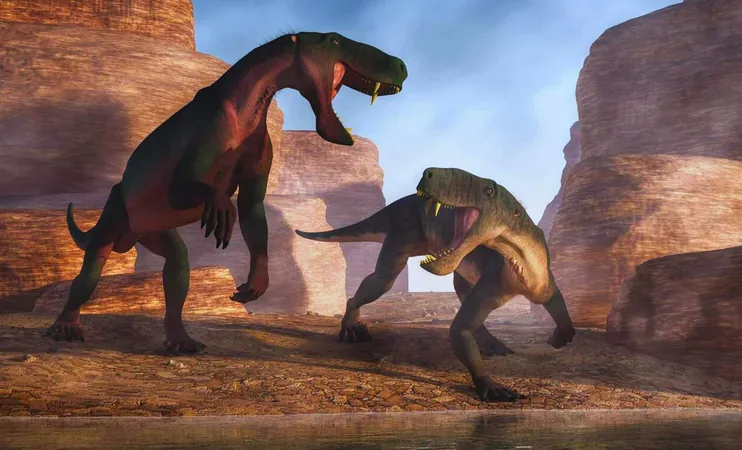
Unveiling Prehistoric Secrets: The Discovery of the Oldest Saber-Toothed Predator Before the Dinosaurs
2024-12-23
Author: Lok
Unveiling Prehistoric Secrets: The Discovery of the Oldest Saber-Toothed Predator Before the Dinosaurs
In a groundbreaking revelation, scientists have unearthed the oldest known ancestor of modern mammals, dating back an astonishing 270 to 280 million years. This remarkable discovery, made on the picturesque island of Mallorca, brings to light a saber-toothed gorgonopsian that roamed the Earth long before the age of dinosaurs.
Therapsids: The Evolutionary Trailblazers
The journey of life on our planet is both fascinating and complex, and a key chapter is written by therapsids—ancient relatives of mammals. Flourishing during the Permian period, these creatures showcased a blend of reptilian and mammalian features, paving the way for the evolution of mammals. The therapsids displayed differentiated teeth, complex jaw structures, and advanced skeletal adaptations, which would influence the design of future mammals.
Their legacy extends beyond mere structural similarities. Some therapsids exhibited early warm-blooded characteristics, hinting at the evolutionary innovations that would eventually lead to the warm-blooded mammals we know today. They filled various ecological roles, resembling modern mammals in both form and function, from herbivores to apex predators.
A Pint-Sized Predator with a Big Impact
The gorgonopsian unearthed in Mallorca marks a significant milestone in the timeline of mammalian evolution. Discovered at the Torrent de na Nadala site in the Serra de Tramuntana, the fossil rewrites the history books by pushing the existence of these saber-toothed predators back by more than five million years. Ken Angielczyk, a prominent paleontologist, emphasizes that while gorgonopsians are not direct ancestors of today’s mammals, they are integral to understanding our lineage.
The fossil site yielded an astonishing array of skeletal remains, including a nearly intact femur, skull fragments, vertebrae, and ribs. Researchers were taken aback by the quantity and quality of these bones. Rafel Matamales from the Museu Balear de Ciències Naturals commented on the rarity of such a find in Mallorca, underlining its significance.
With a size comparable to a husky, this gorgonopsian is equipped with impressive saber-like canines and a built-for-speed physique, cementing its status as an apex predator within its tropical floodplain habitat.
Revolutionizing Our Understanding of Therapsid Origins
Previously, the oldest gorgonopsian fossils were believed to be around 265 million years old. The discovery of this new fossil extends this record, indicating that the evolutionary lineage of therapsids began thriving earlier than scientists had anticipated. It also prompts a reevaluation of their geographic origins, suggesting that they originated in tropical regions of Pangaea rather than the temperate zones of South Africa or Russia.
According to Josep Fortuny, who led the research, this finding transforms our understanding of prehistoric ecosystems.
Therapsids in the Wake of Mass Extinction
The fossil dates to the aftermath of the catastrophic Olson's Extinction, which occurred approximately 273 million years ago and devastated early tetrapods. This pivotal event opened up new ecological niches, allowing therapsids to diversify explosively and eventually dominate the terrestrial landscape.
The Hidden Fossil Treasure of the Mediterranean
The discovery reinforces the potential of fossil sites in the Mediterranean region, such as Mallorca's Port des Canonge Formation, which was once part of the lush equatorial Pangaea. This locale serves as a crucial portal into understanding the unique ecosystems of the tropical Permian era.
Paleontologists assert that this saber-toothed predator is far more than just a fossil; it represents a vital piece of the complex puzzle of mammalian evolution. As more research is conducted on its fossils, experts hope to unlock further secrets about how ancient therapsids evolved into the diverse range of mammals that occupy our planet today.
Stay tuned for more thrilling insights from the past—what other secrets does history hold?


 Brasil (PT)
Brasil (PT)
 Canada (EN)
Canada (EN)
 Chile (ES)
Chile (ES)
 España (ES)
España (ES)
 France (FR)
France (FR)
 Hong Kong (EN)
Hong Kong (EN)
 Italia (IT)
Italia (IT)
 日本 (JA)
日本 (JA)
 Magyarország (HU)
Magyarország (HU)
 Norge (NO)
Norge (NO)
 Polska (PL)
Polska (PL)
 Schweiz (DE)
Schweiz (DE)
 Singapore (EN)
Singapore (EN)
 Sverige (SV)
Sverige (SV)
 Suomi (FI)
Suomi (FI)
 Türkiye (TR)
Türkiye (TR)